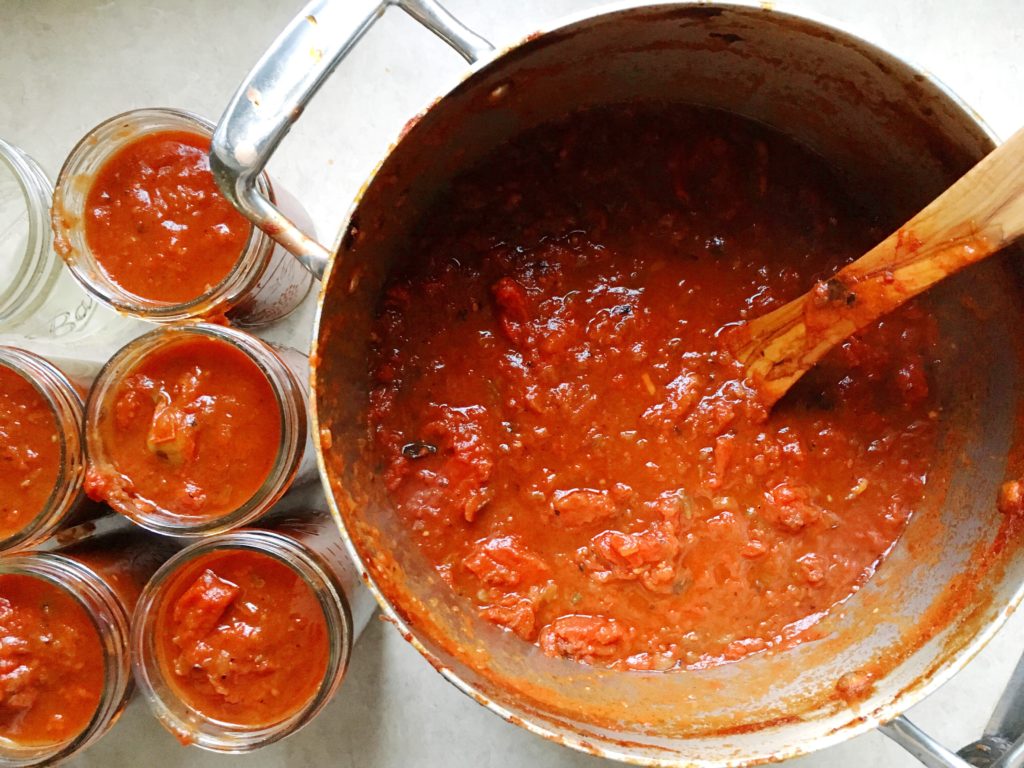
My love of tomatoes is well documented. Every summer, I go on what can only be described as a complete tomato bender. I eat tomatoes for breakfast, as pan con tomate. I eat tomatoes for lunch as a caprese. I eat tomatoes for dinner as a quick-cooking topper for pasta. I make tomato tarts, I make tomato compote. I pop dozens of cherry tomatoes as snacks. I can’t. get. enough.
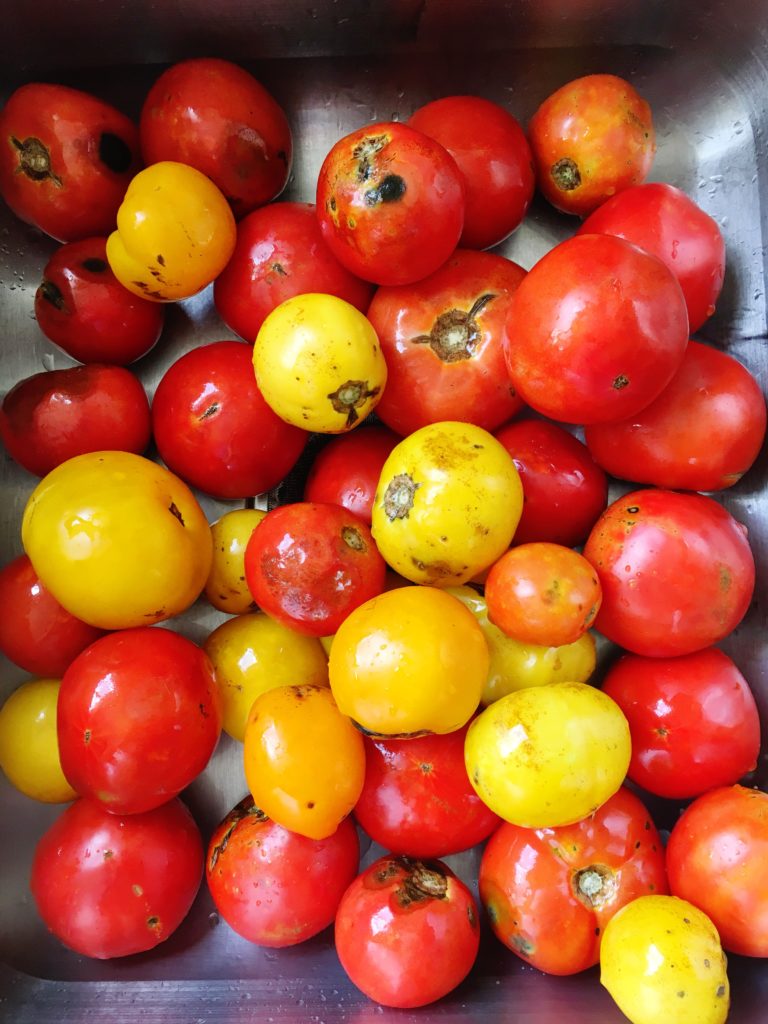
But a couple of weeks ago, I may have outdone myself when–with a garden full of tomatoes–I nonetheless bought a 20-pound box of heirlooms at the farmers market. Even for me, the prospect of getting through twenty pounds of tomatoes in a few days was panic-inducing.
And yet the next week, apparently incapable of learning from my mistakes, I found myself walking away from the market with another 20-pound box of tomatoes.
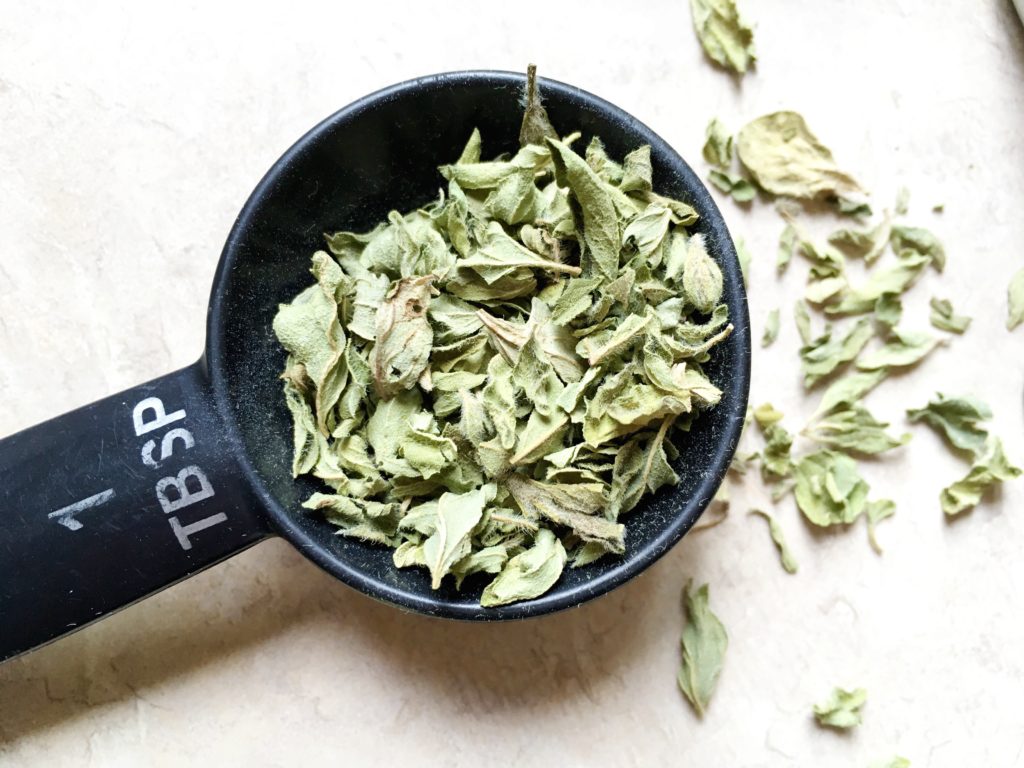
After polling friends and family, I decided to make this new batch of tomatoes into pasta sauce. I had a few requirements:
1. I wanted the pasta sauce to be meatless, so that I could share it with vegetarians (and eat it myself during Lent).
2. I wanted it to be loud. Pasta sauces made from fresh tomatoes can tend toward tasting thin and one-dimensional. I wanted a sauce that packed an umami punch.
3. I wanted it to be relatively thick. Nobody likes a sauce that ends up pooled at the bottom of the plate instead of clinging to the pasta.
4. It needed to be at least ten times as good as store-bought, because um, this is a lot of work.
This recipe nailed it on all fronts.
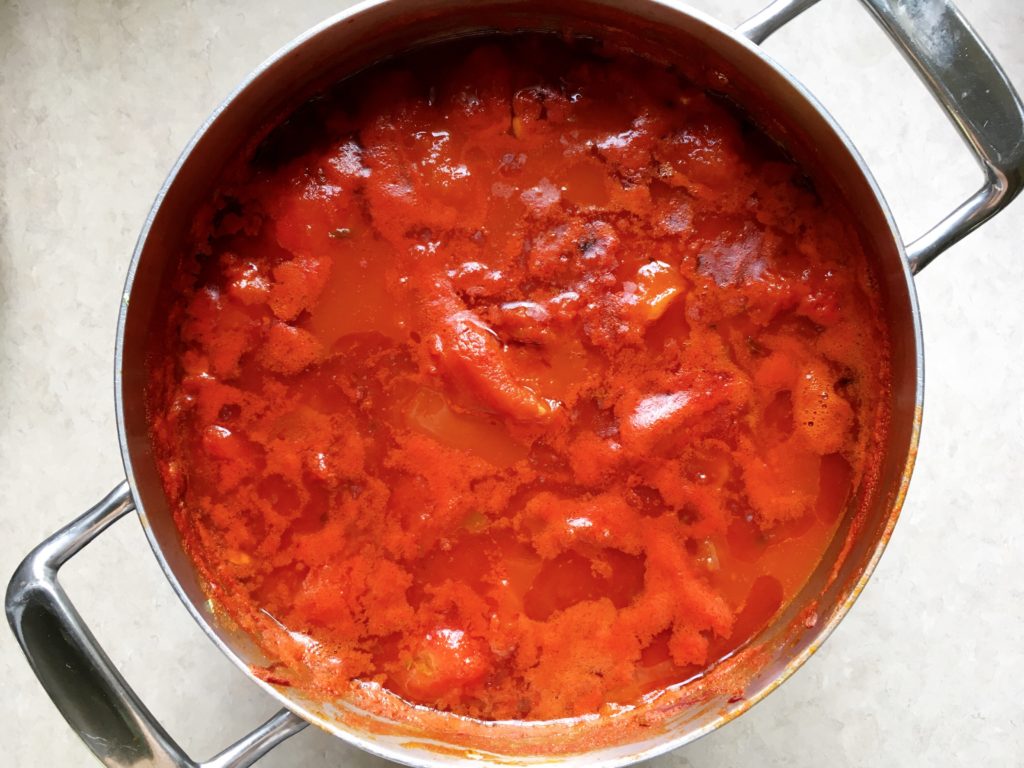
No bones about it: this is a Cooking Project. You’ll need the better part of a day to prep the tomatoes, wait for them to simmer (into that sharp, sweet, deep tomato sauce flavor, zomg), and can the sauce for storage. That said: it was pleasant to potter about in the kitchen on a rainy early fall day, and the results–both in terms of flavor and volume–were well worth the effort. I’ll be enjoying this (and gifting it to my very favorites) until tomato season rolls around again next year.
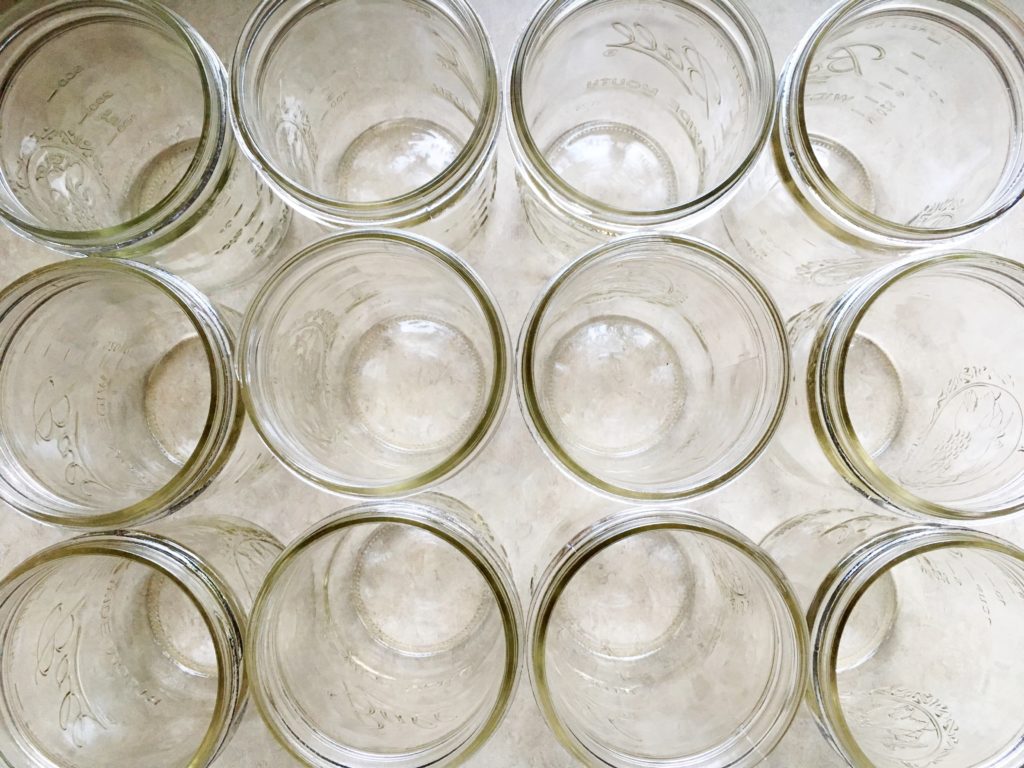
Previously:
One year ago: Salade Lyonnaise + A Little Taste of Lyon
Two years ago: Crackly Banana Bread
And for my Australians:
Six months ago: Roasted Blood Orange Compote
1.5 years ago: Kale Salad with Farro, Parmesan, Pine Nuts, and Dried Fruit
2.5 years ago: Yam and Wild Rice Salad with Lime-Chili Vinaigrette (great salad, terrible photo–it was one of my first posts!)
Bold Marinara Sauce + Instructions for Canning
Adapted from Taste of Home
Makes about 14 16-ounce (454g) jars of sauce
For notes on safe canning, please read the notes following the recipe
Ingredients
For sauce
18.75 pounds (8.5kg) tomatoes
3 green bell peppers, finely chopped
3 onions, chopped
18 ounces (510g) tomato paste
3/4 cup olive oil
1/3 cup (70g) white sugar
3 tablespoons salt
6 garlic cloves, minced
4 teaspoons dried oregano
1 teaspoon red pepper flakes
1 1/2 teaspoons Worcestershire sauce
2 bay leaves
For canning
14 tablespoons (3/4 cup plus 2 tablespoons; 7oz; 207mL) bottled lemon juice (yep, it has to be bottled–see recipe note)
Instructions
Core the tomatoes by making a shallow circular cut around the stem with a small sharp knife. (You just want to remove the small white bit near the top of the fruit.) Then flip the tomatoes over and make a small, shallow x-shaped cut in the bottom.
Bring a very big pot of water to a rapid boil. Fill your sink with ice water. Dump the tomatoes into the pot of boiling water for 60 seconds, then remove, drain, and plunge into ice water. You will need to do this in batches, so remove the first batch of tomatoes with a slotted spoon so you don’t have to re-boil the water.
Remove the tomatoes from the ice water and place in a big bowl. Peel the tomatoes, break them apart into chunks with your hands, and place back into your very big stockpot, reserving whatever tomato juice has accumulated in the bowl.
Add bell peppers, onions, tomato paste, olive oil, sugar, salt, garlic, oregano, pepper flakes, Worcestershire sauce, and bay leaves to the pot. Add enough of the reserved tomato juice to just cover everything in the pot. Bring to a boil. Reduce heat and simmer, uncovered, for 5ish hours, stirring occasionally, making sure to scrape the bottom of the pot when you do.
If you are planning on canning the sauce, sanitize your jars and lids. You can do this by completely covering with water and boiling for at least ten minutes. For the lids, just place in simmering water for ten minutes. Remove the hot jars and lids from the water and place on an clean towel to sit until you are ready to can. (More details on this process here.) Alternatively, you can run them through your dishwasher’s sanitizing cycle. Either way, be sure that the jars remain warm until you’re ready to use them. (I.e., don’t sanitize hours in advance. Just do it when your sauce is about 45 minutes from being ready!)
When the sauce is ready, you have two choices: freeze or can.
If you want to freeze the sauce:
Place in freezer-safe containers, leaving enough headroom for the sauce to expand as it freezes.
If you want to can the sauce:
Add 1 tablespoon of lemon juice to each 16-ounce (454-gram) jar. Ladle the hot sauce mixture into the jars, leaving 1/2 inch (1 1/4cm) headspace. Remove air bubbles if necessary (it wasn’t for me), then adjust headspace, if necessary, by adding more hot mixture. Wipe rims of jars clean with a clean cloth or paper towel (again, trying to keep everything super clean here). Center lids on jars and screw on bands until fingertip tight.
Place jars into a canner or a big pot (I washed out and reused the same one the sauce had been in) of simmering water. Ensure that the jars are completely covered with water. Bring pot with jars to a boil and leave them there, kinda bouncing around, for 40 minutes. (Processing times vary based on altitude– if you’re above 1,000 feet, see the notes at the bottom of the recipe, here.)
Remove jars and let cool. You will hear the lids pop in as they’re cooling!
Notes
Do not experiment: I usually encourage experimentation with recipes, but not here: changing the composition of the recipe can change the pH, which is how you get botulism.
Lemon juice: This is also why the recipe calls for bottled lemon juice, rather than fresh: bottled offers a standardized acidity that ensures safe canning.
As a result, if you are using larger jars, you will need to add more lemon juice to each jar. This recipe calls for 16-ounce jars and 1 tablespoon of lemon juice per jar; if you are using quart jars (32 ounces), you would need to use 2 tablespoons per jar.
Or you can just freeze it: Does all of this sound confusing, terrifying, and possibly deadly? It’s not, once you get the hang of it. But if you’re scared and/or you have more room in the freezer than you do in the pantry, just freeze the sauce in your favorite freezer containers! It’s not as easily given as a gift, but tbh, this pasta sauce is almost too good to share, anyway.
Leave a Reply